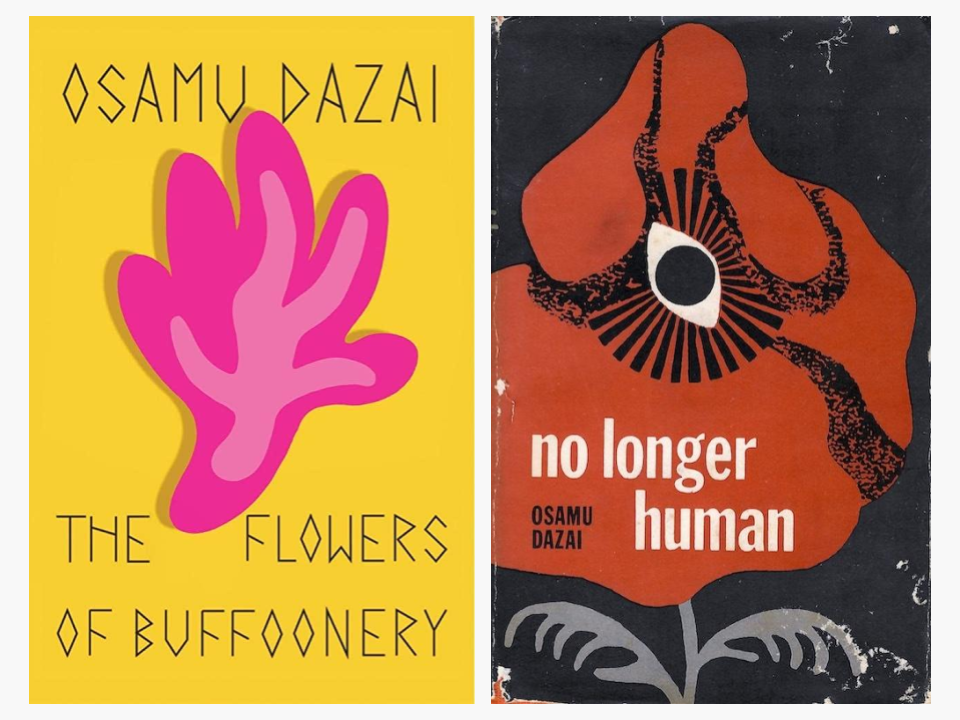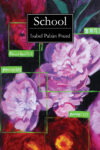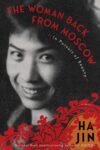
[New Directions; 2023]
Tr. from the Japanese by Sam Bett
1.
Much mythologized in his home country, the mid-twentieth-century Japanese writer Osamu Dazai remains little known in the West, even some seventy years after he was first translated into English. This creator of moody, Dostoevskian heroes—toeing the line between brutality and beauty, cynicism and élan—has the kind of biography that threatens to overshadow the work itself, and that’s before you realize that most of what Dazai wrote is taken to be autobiographical. Dazai was born into the Japanese aristocracy of the early twentieth century, and as a young man he fell in with literary types, prostitutes, and Communists. In the 1930s he came to prominence as a writer of stories and novels. During the war years, he avoided becoming an outright propagandist but was hardly antigovernment, retreating from the issues of the day by writing historical pieces and retold fairy tales. By most accounts he reached the pinnacle of his literary powers in the early postwar period. His two final books, The Setting Sun and No Longer Human, were released in the late 1940s and are often recognized as among the most important Japanese novels of the twentieth century. But this late flowering came during a period of personal misery. He became estranged from his family and involved in a series of unhappy liaisons. He drank heavily. In 1948, he and a lover drowned themselves in the Pacific.
Dazai’s death was sensationalized by the Japanese media, and he was inculcated as a symbol of kyodatsu, the condition of depression and despair associated with early postwar Japan and the American occupation. Unfairly or not, Dazai’s connection to suicide—he attempted to kill himself at least four times prior to his deat—would come to define his literary reputation. The last section of Dazai’s final novel, No Longer Human, was published in the weeks before his death and like its predecessor, The Setting Sun, focuses on a suicidal character. No Longer Human is presented as containing three notebooks written by Yozo Oba, who, like Dazai, is a dissolute, wayward son of the Japanese aristocracy. Although Yozo’s fate is left open-ended at the end of the book, it is clear we are meant to imagine that things don’t end well for him. In the climax of the book’s second section, which describes Yozo’s student years, he and a lover attempt suicide by throwing themselves into the ocean; Yozo survives, but his companion does not. His fixation with doing away with himself only deepens as the book progresses:
The feelings which assailed me as I looked up at the summer night sky heavy with rain were not of fury or hatred, nor even of sadness. They were of overpowering fear, not the terror the sight of ghosts in a graveyard might arouse, but rather a fierce ancestral dread that could not be expressed in four or five words, something perhaps like encountering in the sacred grove of a Shinto shrine the white-clothed body of the god. My hair turned prematurely grey from that night. I had now lost all confidence in myself, doubted all men immeasurably, and abandoned all hopes for the things of this world, all joy, all sympathy, eternally.
In 1958 New Directions brought out an English translation of No Longer Human, which followed the release, two years earlier, of The Setting Sun. Both were translated by the prolific Japanologist Donald Keene, who also included Dazai’s work in his anthology of Japanese literature, Dawn to the West. Over the succeeding decades, while more pieces of his oeuvre were translated into English, Dazai’s work never found a large audience in the anglophone world, even as he remained a boldfaced literary name in his native country, with his fiction adapted into manga and referenced by a popular anime series. In the West, Dazai has received less critical attention than his daughter Yuko Tsushima, born just a year before his death, who focused on the plight of single mothers in her fiction, and another writer who took his own life, the strident reactionary Yukio Mishima.
Earlier this year, New Directions released a Dazai novella never previously published in English, The Flowers of Buffoonery, which happens to feature the author’s most famous protagonist, the debauched rogue Yozo from No Longer Human. This moment provides another opportunity for Western readers to gain a deeper appreciation for Dazai and his nuanced portraits of degeneracy, alienation, and melancholy.
2.
No Longer Human is a leading example of the I-novel, a Japanese tradition of confessional autobiographical fiction similar to autofiction in the Western world. Unlike with autofiction, however, Japanese readers of I-novels expect that the events described hew closely to reality; there’s an aspect of voyeurism to the genre, and the more lurid the story, the better. In this respect No Longer Human does not disappoint. Yozo Oba is an alcoholic, a drug addict, and a womanizer, and he narrates his foibles with a scornful cynicism that appears to delight in his misdeeds while disavowing them at the same time. “Don’t be like me, but listen to how bad I was,” he seems to be saying. On the one hand, the book could be read as a kind of journey to the abyss; the reader follows Yozo down the drain of his misbehavior, hoping against reason that he will redeem himself and feeling more sympathy for the characters Yozo manipulates and ruins than for the protagonist himself. That we know how the author’s life ended only deepens the macabre appeal.
The problem with reading No Longer Human as the testimony of an unrepentant reprobate is that it relies on a Manichean view of human nature that simply doesn’t ring true. Even taking Yozo’s transgressions as the embodiment of a toxic, antiquated regime—namely, the Japanese military-industrial complex of the 1930s—fails to give the book sufficient depth. We don’t read novels simply to be presented with an ailing society’s diagnosis or confronted with the worst impulses of human behavior, or at least some of us don’t; we read to get a window into the unavoidable, sometimes unresolvable conflicts that define our lives, and our deaths. Approach No Longer Human in a different way, however, peeling back the veneer of unapologetic Lotharioism, and a more troubling, dynamic book emerges.
One way in which Dazai goes against the conventions of the I-novel in No Longer Human is his use of a framing device. The commentary by an unnamed narrator at the beginning and end of the novel allows Dazai to put distance between himself and Yozo. The three notebook sections that constitute the vast bulk of the novel then become a kind of case study. The reader is not so much identifying with Dazai as viewing him from a remove. In the prologue, the narrator describes a series of pictures of Yozo from childhood, adolescence, and early adulthood and implies that the pictures reveal a character who is troubled from the very get-go. The depth of Yozo’s problems is surmisable in a glance. Yozo’s childhood smile is “nothing more than a puckering of ugly wrinkles . . . I have never seen a child with such an unaccountable expression.” The last picture is extremely disturbing to the narrator. Yozo’s face has “no individuality” and “makes the beholder shudder in distaste.” The title of No Longer Human—translated literally from the Japanese, Keene explains in his introduction, it is “Disqualified as a Human Being”—implies that Yozo loses his humanity due to his misdeeds. But, by presenting these dehumanizing descriptions of Yozo’s photographic record before the reader has properly met him, the prologue wants to make us think that he never had a chance in the first place.
In his notebooks, Yozo embraces this notion of being doomed from the start while nevertheless dropping hints at a humanity that was thwarted rather than disavowed. A sickly and neglected child, Yozo feels disassociated from the other members of his wealthy family. He takes on the role of a clown, but only as a way to hide his inner sadness. His life is defined by pain: “People have told me, really more times than I can remember, how lucky I was, but I have always felt as if I were suffering in hell.” The now-recognized connection between mental and physical anguish is apparent in later sections of the novel as well, as when Yozo reflects on the origins of his inescapable “wound”: “In my case the wound appeared when I was an infant, and with the passage of time, far from healing it has grown only the deeper, until now it has reached the bone. The agonies I have suffered night after night have made for a hell composed of an infinite diversity of tortures.”
Although Yozo may want to believe that he was born with this pain, or that it emerged only months afterward, an event from later in his childhood is a more believable source. He is the victim of sexual abuse. Yozo refers to his trauma obliquely and with resignation:
Already by then I had been taught a lamentable thing by the maids and menservants; I was being corrupted. I now think that to perpetrate such a thing on a small child is the ugliest, vilest, cruelest crime a human being can commit. But I endured it. I even felt as if it enabled me to see one more particular aspect of human beings. I smiled in my weakness.
If No Longer Human were being written today, this “loathsome crime,” as Yozo puts it, might be at the center of the narrative, as we now know so much more about how a traumatic childhood can lead to mental illness as an adult. But it is buried in the novel. One of the book’s harshest scenes, when Yozo witnesses his wife, Yoshiki, being raped and does nothing to stop it, contains a subtle reference to Yozo’s childhood trauma. Watching the spectacle, Yozo reflects to himself, “This is just another aspect of the behavior of human beings. There’s nothing to be surprised at,” repeating the justification employed to repress his earlier abuse.
In an effort to escape his neglectful family, Yozo also seeks to exile himself from his class as a whole. In a section no doubt informed by Dazai’s own experiences in the political underground, Yozo studies Marxism and becomes a fellow traveler of the Japanese Communist Party. This part of the book furnishes some rare moments of genuine humor, as when Yozo observes in an aside the drama attached by Party members to various low-stakes cloak-and-dagger escapades: “The missions on which I was employed were really of a stupefying inconsequentiality, but the comrades kept themselves worked up into a state off frantic excitement by incessantly reminding themselves how dangerous these errands were.” Yozo eventually tires of the materialist framework, feeling that there is “something inexplicable at the bottom of human society which was not reducible to economics.” And yet he is unable to free himself from economic realities. Yozo is dogged by money problems throughout the novel; indeed, some of his worst crises emerge when he’s at his most destitute. It’s as if Yozo, this self-disgusted child of privilege, can bear neither poverty nor wealth. Yozo’s first suicide attempt, the one that ends the life of his lover, is precipitated in part by the realization that he only has three copper coins to his name. “My only possessions were the kimono and coat I was wearing. These were the hard facts. I perceived with clarity that I could not go on living.”
Despite what the narrator of the prologue would have us believe, and despite what Yozo, in his darkest moments, tells us directly, there is nothing inherent in his character that leads him to suicide. His death is not a fait accompli but the result of circumstances that might have been different. The problems he faces are caused not by his inhumanity but by his humanity, sadly familiar and flawed, and the humanity of those around him.
3.
Some of the early press for The Flowers of Buffoonery, the book newly released by New Directions, described it as a “prequel” to No Longer Human, which had stumped me since No Longer Human was Dazai’s last novel, and my understanding was that a prequel is a work meant to precede another but generally created after it. In actuality Dazai wrote The Flowers of Buffoonery thirteen years before No Longer Human; it’s more correct to say that No Longer Human is the sequel, as well as a prequel, given that it includes events before and after those described in The Flowers of Buffoonery. Regardless of timelines, what’s important is that Buffoonery provides English readers a new picture of Yozo—before No Longer Human. This short book is the seed from which the later masterpiece emerged.
The half-failed, half-successful double suicide that is so important in No Longer Human is the precipitating event for Buffoonery. The novel describes the days immediately following, when Yozo, after being fished out of the sea, is sent to recuperate at a sanatorium while awaiting his legal fate. In No Longer Human, Dazai briefly summarizes the action described at length in Buffoonery; in the earlier work we know little of Yozo’s background or upbringing. The books overlap only slightly.
Unlike its sequel, The Flowers of Buffoonery is written entirely in third person, although the narrator makes frequent asides to the reader, often commenting ironically on the construction of the novel as it occurs. The tongue-in-cheek breaking of the fourth wall has little in common with the dour, sometimes melodramatic tone of No Longer Human but has a similar effect in distancing us from the protagonist:
To begin, who is this Yozo Oba character? I wrote him into being, drunk on a substance far more potent than alcohol. There could be no better name for my protagonist. “Oba” flawlessly encapsulates his vigorous spirit, while “Yozo,” I must say, has pizazz. It conveys a certain freshness, to be accessed only if one sinks into the depths of the old-fashioned. Not to mention the phonic harmony of those four vowel sounds in a row. Yozo Oba. Have I not already dazzled you with my creations? Well then, feast your eyes on Yozo Oba, our protagonist, seated on the bed and staring at a sea clouded with rain. As dazzling a creation as they come!
And so we look on as Dazai, faltering and grumbling to himself, wills into being the story of Yozo’s recovery. The entire novel takes place at the sanatorium, mostly in Yozo’s room. With a single setting, large amounts of dialogue, and frequent interjections from the narrator, it reminds one of a play. Despite the circumstances, a lively cast of characters keeps the story from becoming too morbid. Yozo has two visitors, his friend Hida and his cousin Kosuge, who have come to check on him, as well as a nurse, Mano. The foursome play cards, tell jokes, and trade stories, all while tiptoeing around the incident that has brought them together. When Yozo’s older brother, the representative of the family, arrives in order to clean up the mess by negotiating with the authorities and paying off Yozo’s dead lover’s husband, the effect is like that of the police temporarily breaking up a house party.
The Flowers of Buffoonery is suffused with a youthful ambivalence that by No Longer Human has solidified into a hardened cynicism. Where in the later novel, Yozo leads us to believe that he never really bought what the Communists were selling and was really only involved in leftist politics as a kind of lark, here he isn’t afraid to profess to more noble aims, even though he failed in fulfilling them: “Handing out leaflets, staging demonstrations . . . It was absurd. But it was tough work. What kept me going was this fantasy of being some kind of an enlightened person. That only got me so far, though. No matter how I struggled, things always fell apart.” Nothing so baldly honest and sentimental appears into No Longer Human. The book is also different from No Longer Human in it that is includes characters who display a deep appreciation, even love, for Yozo. Kosuge is a few years younger than his cousin and has looked up to him all his life, and yet even as he admires Yozo, he senses the danger he faces. Pick any page from The Flowers of Buffoonery, and it will probably reveal more instances of authentic human connection than can be found in the entirety of No Longer Human.
One of the best recent books on mental illness and suicide is Donald Antrim’s memoir One Friday in April, which describes a period in which the author came close to killing himself and had to be hospitalized. I have been keen to avoid using the word “depression” in describing Yozo’s condition, partially because the character and his author come from a period prior to the widespread adoption of the term, but also out of deference to what I have learned from Antrim. Here is Antrim’s description of what he suffered:
When telling the story of my illness, I try not to speak about depression. I prefer to call it suicide. . . . I do not think of suicide as the act, the death, the fall from a height or the trigger pulled. I see it as a long illness, an illness with origins in trauma and isolation, in deprivation of touch, in violence and neglect, in the loss of home and belonging. It is a disease of the body and the brain, if you make that distinction, but its etiology, its beginning, whether in early or later life, in the family or beyond, is social in nature. I see suicide as a social disease.
It’s possible now to see the Yozo of No Longer Human not as a victim of inherent humanity, amorality, or even upper-class ennui, but rather the more quotidian and yet arguably more vicious demons laid out by Antrim: trauma and isolation, deprivation of touch, violence and neglect, loss of home and belonging. What’s heartbreaking about reading The Flowers of Buffoonery after knowing how No Longer Human ends is to see Yozo at a moment when he is wounded but not yet broken, disillusioned but not yet hopeless. Most importantly, he is not yet alone.
Wilson McBee lives in Highland Park, Illinois.
This post may contain affiliate links.







